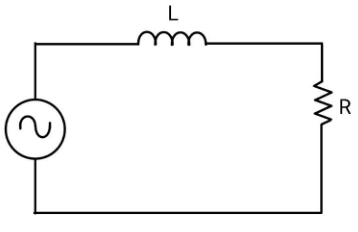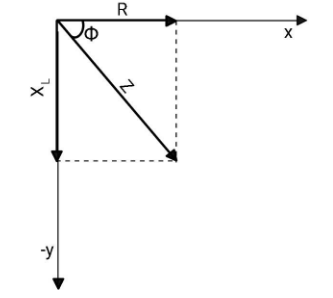
An inductor and a resistor in series are connected to an A.C. supply of variable frequency. As the frequency of the source is increased, the phase angle between current and the potential difference across

A. First increase and then decrease
B. First decrease and then increase
C. Go on decreasing
D. Go on increasing

Answer
474.3k+ views
Hint: Here we have to find a relation between the frequency of the applied AC source and the phase angle between the current and the potential difference across L, so it will help to find the variation in phase as frequency is increased. To get this, use the vector method.
Complete step by step answer:
In vector method, the resistance is represented by a vector of magnitude

From here, you can find the tangent of the phase angle
Now,
If the frequency of the applied source increases, the tangent of the phase angle increases. Implying that the phase angle between the current and the potential difference will also increase.
Hence, as the frequency of the source is increased, the phase angle between current and the potential difference across
Additional information:
In the above case, the current is given as
In case of RC circuit, the tangent of the phase angle is given as
Note: Always remember the vector representation. The resistance is represented along the x-axis, reactance of inductor along negative y-axis and reactance of capacitor along positive y-axis. This will help you in solving many questions related to alternating current.
Complete step by step answer:
In vector method, the resistance is represented by a vector of magnitude

From here, you can find the tangent of the phase angle
Now,
If the frequency of the applied source increases, the tangent of the phase angle increases. Implying that the phase angle between the current and the potential difference will also increase.
Hence, as the frequency of the source is increased, the phase angle between current and the potential difference across
Additional information:
In the above case, the current is given as
In case of RC circuit, the tangent of the phase angle is given as
Note: Always remember the vector representation. The resistance is represented along the x-axis, reactance of inductor along negative y-axis and reactance of capacitor along positive y-axis. This will help you in solving many questions related to alternating current.
Recently Updated Pages
Master Class 12 Economics: Engaging Questions & Answers for Success

Master Class 12 Maths: Engaging Questions & Answers for Success

Master Class 12 Biology: Engaging Questions & Answers for Success

Master Class 12 Physics: Engaging Questions & Answers for Success

Master Class 12 Business Studies: Engaging Questions & Answers for Success

Master Class 12 English: Engaging Questions & Answers for Success

Trending doubts
The probability that a leap year will have only 52 class 12 maths CBSE

Draw a labelled sketch of the human eye class 12 physics CBSE

The final image formed by a compound microscope is class 12 physics CBSE

Differentiate between homogeneous and heterogeneous class 12 chemistry CBSE

What are the major means of transport Explain each class 12 social science CBSE

Which of the following properties of a proton can change class 12 physics CBSE




